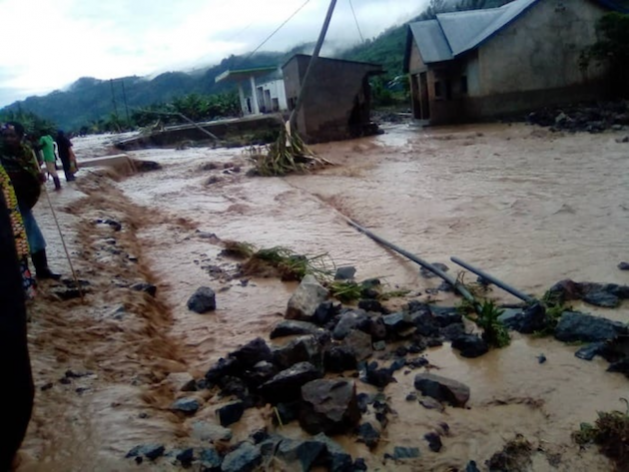
[ad_1]

KIGALI, Might 19 (IPS) – Following extreme flooding and landslides that hit main components of Rwanda earlier this month, specialists are satisfied that investing within the mapping of abrasion danger areas may go an extended method to retaining the variety of casualties down.
Many villagers residing alongside main rivers in Western Rwanda have been among the many victims of river erosion and flooding yearly.
Felicita Mukamusoni, a river erosion survivor in Nyundo, a mountainous village from Western Rwanda, advised IPS that “components of this village have been eroded to such an extent that we can not even think about.”
“I reared cows and goats. My lovely home was destroyed. The river has taken every little thing,” she mentioned.
Newest Authorities estimates point out that not less than 135 individuals died, and one continues to be lacking following current flooding and landslides triggered by heavy rains that hit western, northern and southern provinces earlier this month.
In a current evaluation, specialists discovered that land in high-risk areas is principally used for agriculture, and 61 % was for seasonal crops. It mentioned that seasonal agriculture exposes soil to splash erosion and additional detachment as land just isn’t completely coated.
The 2022 report on the State of Soil Erosion Management in Rwanda signifies that the erosion management strategies throughout high-risk areas in Rwanda are nonetheless very low.
Erosion management mapping reveals that of the 30 districts of Rwanda, land beneath excessive erosion danger is about 1,080,168 hectares (45 % of the whole provinces land, which is estimated to be 2,385,830 hectares) of which 71,941 hectares (7 % of the whole danger areas) are at extraordinarily excessive danger.
In keeping with the identical report, not less than 190,433 hectares of land are thought of very excessive danger (18 %), 300,805 hectares are at excessive danger (28 %), and 516,999 hectares (48 %) are at average danger.
Dr Charles Karangwa, a local weather skilled primarily based in Kigali, advised IPS that It’s unlucky that recent disasters occurred once more regardless of loads of funding prior to now.
“Rwanda must discover different complementary options akin to water administration infrastructure, water harvesting, and the place attainable, relocate these residing in extremely dangerous areas to permit nature to regenerate will assist to stabilise the scenario each in the long run and medium time period,” he mentioned.
Other than being extremely populated, Karangwa identified that there’s fairly a hyperlink with geographical vulnerability due to soil erosion danger, which is worsened by excessive inhabitants, and this elevated stress on land.
Flood Administration and Water Storage Growth Division Supervisor at Rwanda’s Water Assets Board (RWB), Davis Bugingo, advised IPS that amongst options to deal with recurrent disasters in Western Rwanda is the institution of flood management infrastructures to control water circulate and cut back flooding dangers.
These embrace the development of the neighbouring Sebeya retention dam, and Gisunyu gully rehabilitation works anticipated to considerably contribute to decreasing flood impacts within the area.
Whereas correct and up-to-date knowledge on river circulate, topography, and flood vulnerability stays essential for efficient flood administration, Bugingo noticed that restricted knowledge availability and high quality may pose challenges in correct flood forecasting, danger evaluation, and planning.
Other than land use, which contributed to elevated flood dangers, specialists noticed that constructions in flood-prone areas, encroachments on riverbanks, and insufficient zoning laws had exacerbated the influence of floods and hindered efficient flood administration efforts in western Rwanda.
Most not too long ago, RWB has developed a devoted software to gather extra info to tell future evaluation, relocation of individuals residing in dangerous areas, and adjusting instruments used to design flood management infrastructure.
The above instrument gives info on flood publicity and areas in danger that may be visualised in 3D and shared the data with the general public or different organisations. Nonetheless, specialists are satisfied that regardless of these revolutionary options, restricted monetary sources could hinder the implementation of those large-scale infrastructure tasks, akin to dams, flood management buildings, gully reclamation and drainage techniques.
Rwanda is one among Africa’s most densely populated international locations, with giant concentrations within the central areas and alongside the shore of Lake Kivu within the west. This East African nation’s complete space is 26,338 km2, with a inhabitants of 13,246,394.
Bugingo factors out that insufficient land use nonetheless contributes to elevated flood dangers.
“Constructions in flood-prone areas, encroachments on riverbanks, and insufficient zoning laws proceed to exacerbate the influence of floods and hinder efficient flood administration efforts,” he mentioned.
IPS UN Bureau Report
Follow @IPSNewsUNBureau
Follow IPS News UN Bureau on Instagram
© Inter Press Service (2023) — All Rights ReservedOriginal source: Inter Press Service
[ad_2]